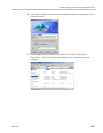
Polycom® RealPresence Collaboration Server (RMX) 1500/2000/4000 Administrator’s Guide
H-2 Polycom, Inc.
TLS certificates can be generated using the following methods: CSR, PFX and PEM; each
giving different options for Encryption Key length. Table H-1 lists the SIP TLS Encryption Key
length support for the various system components.
Conferencing Entities Presence
Conferencing entities (Meeting Rooms, Entry Queues and SIP Factories) can be registered
with the SIP server (Office Communication Server or Lync server) enabling the addition of
these conferencing entities to the buddy list while displaying their presence (availability
status: Available, Offline, or Busy). Office Communication Server client or Lync Server
client users can connect to conferencing entities directly from the buddy list.
The configuration of the environment to enable Presence, is usually done once the basic
configuration is completed.
For more details, see "Adding Presence to Conferencing Entities in the Buddy List” on page H-55.
Multiple Networks
A more complex configuration, in which two Microsoft SIP servers are used (one Lync
Server and one Office Communications Server) is also supported using the Collaboration
Server Multiple Networks configuration.
In this configuration, each Microsoft SIP Server is defined in a Network Service of its own
(in this case two IP Network Services are defined). A DNS server can be specified for each IP
Network Service and for the RMX Management Network Service.
Table H-1 SIP TLS - Encryption Key Support by System Component
System Component Key Generation Method Key Length (bits) Key generated by
SIP Signaling
CSR 2048 Collaboration
Server
PFX / PEM 1024 or 2048 User
Management
CSR 2048
Collaboration
Server
LDAP


















